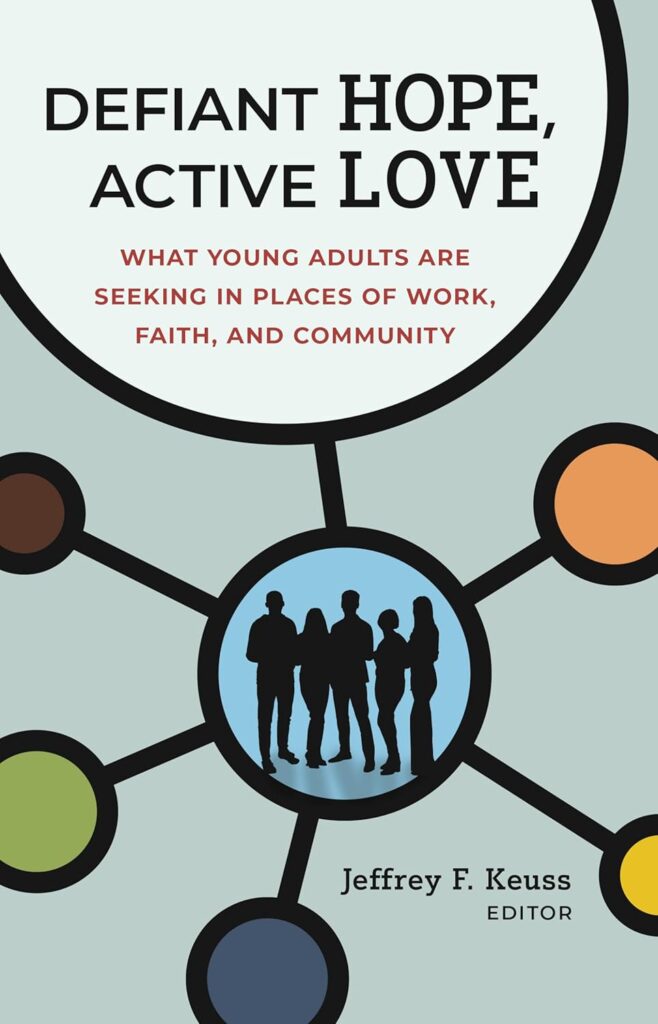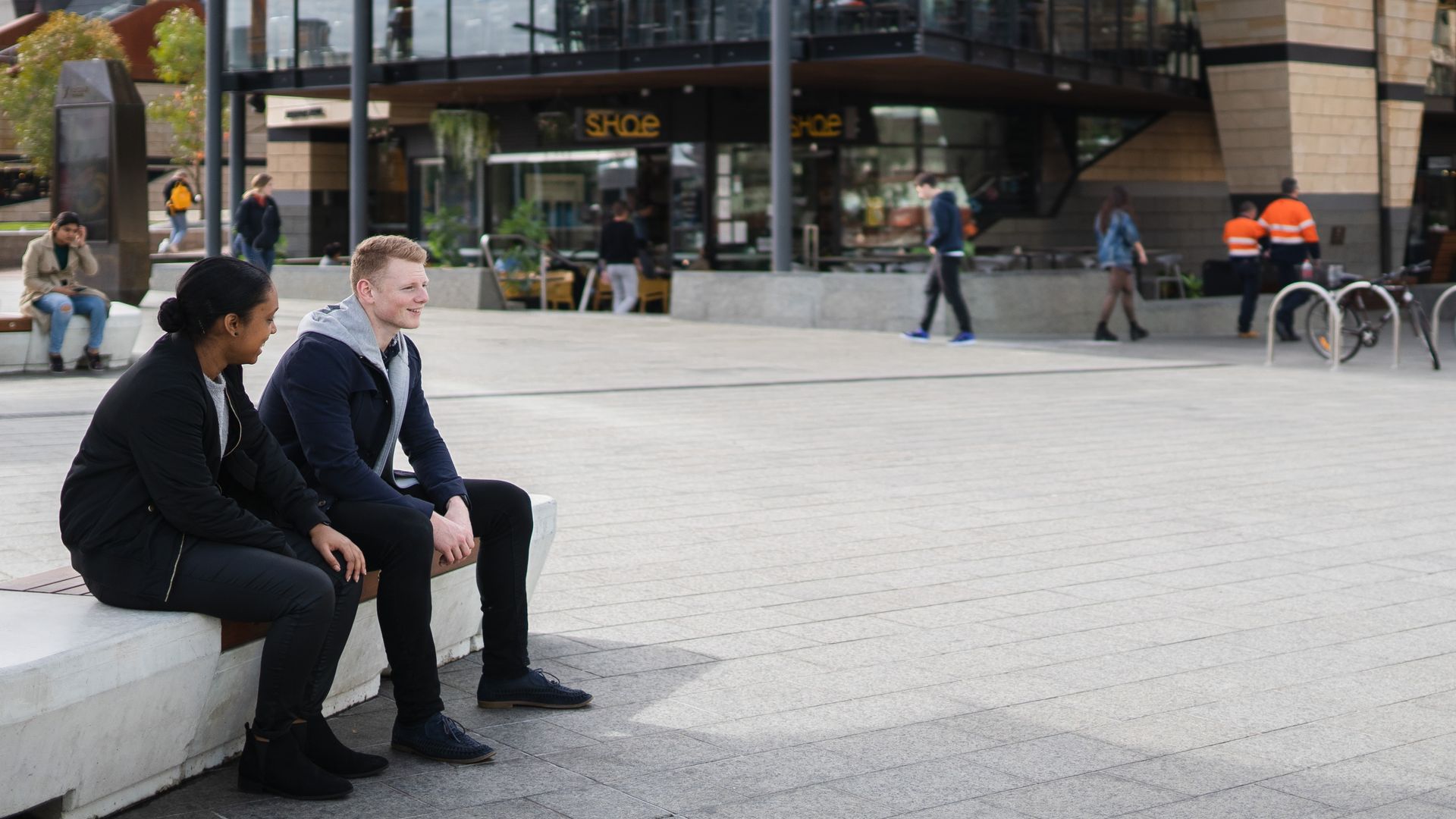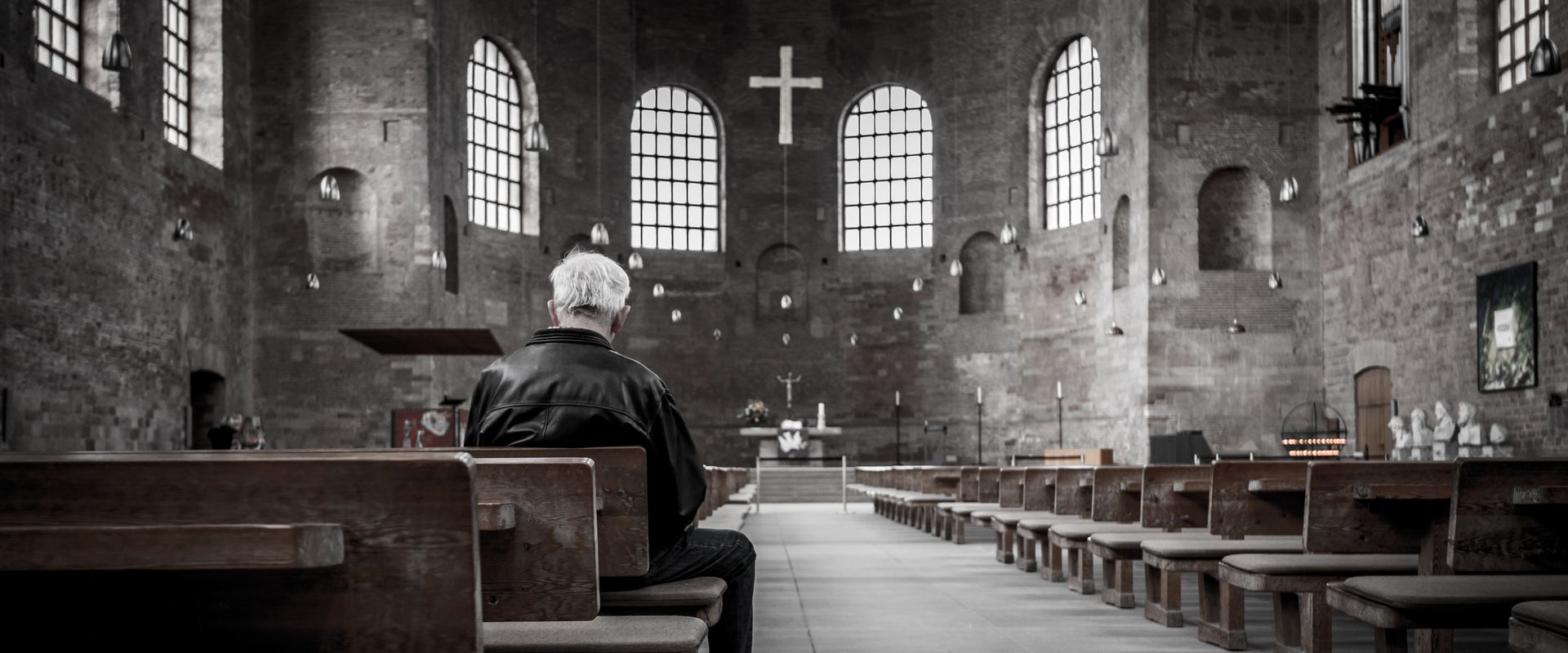
Defiant Hope, Active Love: What Young Adults Are Seeking in Places of Work, Faith, and Community
(Eerdmans 2024)
Edited by Jeffrey F. Keuss
“Attributing a sense of certainty to God, meaning I already know what God’s going to do, will kill hope. Also, despair will kill hope. In both cases, young adults are ready for real hope. They’re not despairing as much as people think and they’re certainly not certain, meaning that their doubts and questions are more open for the aperture of faith than ever before.”
— Jeffrey F. Keuss
When leaders at the Lilly Endowment approached Jeffrey Keuss, a professor at Seattle Pacific University, they had a question — a $55 million question, in fact.
U.S. Census Data from 2016 revealed that 22 to 29-year-olds were the second largest demographic in the country, only outsized by baby boomers. Not only that, but young people were the least likely to attend any type of religious institution, be it a church, a synagogue, or a mosque. Concerned by this trend, the Lilly Endowment funded research led by 11 principal investigators, Keuss and his team being one of them.
“We had some pretty startling findings — things that we thought were pretty distinctive and unique,” Keuss told Common Good. “We wanted to start publicly getting some of this information out and talking about ways that churches can respond, how can Christians respond, and how can faith leaders respond to these trends.”
If the word startling has you a little nervous — take heart. Keuss and his team, whose findings are now published in Defiant Hope, Active Love: What Young Adults Are Seeking in Places of Work, Faith, and Community, come bearing good news. Trends may be changing, but the hearts of many young adults are open.
Keuss spoke with Common Good earlier this summer about his research and how he hopes to encourage faithful ministers. Here’s that conversation.
Which of the startling trends your team discovered especially stands out to you?
We spent time over three years sitting with young adults in church basements, taverns, gyms, yoga studios, mountaineering clubs, and more — gathering people together, asking questions, and then recording and coding responses.
One of the things we heard from a lot of church leaders was that young adults — defined as Gen Z and young millennials — don’t like churches. Leaders said that young people find churches repressive and authoritarian and that they find leaders hypocritical.
That was not what the data showed.
There are certainly outliers on both ends of the data where you have people who don’t like any institutional leadership — they have been hurt by authority figures in their life in various ways and they’re very responsive to that.
But a majority of young adults think churches are great. They think churches are amazing. They are agents of social change. They have the capacity for justice. They are one of the few places where you can have multi-generational engagement anymore.
It wasn’t, Churches should be burned down! Institutions should be destroyed! We hate church leaders! That’s just not true. And so that was a very important point for us to remind church leaders: Young adults do not want your church to shut down. And we’re seeing this across progressive and conservative data collection.
Second, we found that young adults want to participate in leadership in churches. Part of the challenge for many young adults is, How do I participate in faith communities? How do I bring the skills and talents that I get to use in many of my places of work into the church?
[Essentially they are saying], “I work at Amazon, or Boeing, or Google. I’m doing gig economy work for three different people. But when I go to churches, I’m treated like I’m in a youth group. I’m treated like I somehow need to be in the back pew and wait to grow up. But everywhere else in my world, I’m balancing multi-million-dollar budgets. I have leaders that I’m working with. So why am I not seen in leadership at church?”
So, something we communicated pretty directly to a lot of leaders was: You need to start giving away leadership. We talked about a model of moving from leadership development to leadership identification. Lee Roy Barber uses this language quite a bit, particularly in BIPOC communities, which is — as opposed to telling the young adult, “Well, we need to develop you into leaders,” — telling them, “You already are a leader. And so let’s give you some of the experience of doing that.” Which, for older members of churches, means there’s a need to sit back and let people lead you.
The third thing: It comes down to money. Young adult participation in faith communities is often hampered by the capacity for them to earn a living — to try to make their life work. They’re working terribly hard. And this is particularly a message that comes to single young adults, which is like, Well, you’re single, you must have all the time in the world. So you can come here and do this and serve in this way.
And yes, there’s some discretionary time at the margins of people’s lives. But people are very worried about their economic status. And this is why the last chapter of the book deals with what we call “deep poverty,” which considers how we align the spiritual and theological questions that young adults have with the very economic realities that they’re trying to face.
I’ve told a number of churches this — if you took the street-facing sign that typically features a sermon title or an ironic saying and instead wrote, “We will help you find work,” you’d probably have a lot of young adults showing up at your church. This means being more frank about what it takes to live our lives day to day and giving space for people to consider that together.
What are some of the pragmatic opportunities churches have to engage economic concerns?
Evangelical Christians by and large have had a hard time talking about money. It’s been a dirty conversation — like we shouldn’t have to talk about money because God provides and you trust in the Lord, you don’t have to worry about the numbers.
There’s nothing in Scripture to support that kind of mentality. Jesus talks about money quite a bit. It’s a very serious thing. Helping people to be able to feed themselves, get housed, and have a holistic sense of life so they can give to the next generation is front and center from Exodus 9 through the ministry of Jesus. It’s the question that Moses very bluntly asks of Pharaoh: How can you expect our people to survive in this kind of perpetual sense of poverty? This is not endurable and this is not seeing the image of God in others.
This is why the Sabbath was created in a time of slavery. The call to live a sabbatarian life was under the boot of Pharaoh, right? Sabbath says: You need to separate yourself from that engine for a season so people can see you as a human being and not merely a tool.
So industry and the way that it shapes us as human beings is key. At the end of the book, when I get into the economics question, we look at some of the happiness scales, we look at other nations and how they’re kind of affording space for young adults to kind of transition into life, housing questions, what it means to overcome the issues of being a perpetual renter and getting a foot into the equity ladder. These are very real questions for the young adults we’re talking about.
There’s a communal responsibility to help them find a sense of holistic peace — that’s what we’re talking about when we’re addressing deep poverty. So in the book, we asked, How do we apprentice people into a sustainable livelihood? Churches could do a lot of that work — through systems like reverse mentorship and collaboratively creating leadership opportunities — quite well.
Older adults also need to consider what it looks like to give up capital — housing, job internships, opening up their network more broadly, being very blunt about helping people get those positions that they’re hoping for, and not penalizing young adults for the fact that they live in a different economic reality than the people who earned wealth 40 years ago.
In the introduction of the book, it says, “There’s a thirst for something beyond the artifice and deadness that the fossilized trees of religious institutions want to offer young adults. And the first is finding new wells to drink.” What might those new wells look like?
I find it funny that the early church started as a missional activity of going out and we have now moved into a scarcity model of keeping people in. There’s such a panic in the industry of churches that losing people means losing our buildings and losing our pensions. Property and pensions are the two things that haunt the back screens of a lot of pastors and priests. I don’t mean this in a crass way; I mean it in a very real way.
But young adults want to be met at the places where they’re finding life and life abundantly. These are those new wells. For example, we had a meeting with a young adult group, and we were saying, “Okay, where are the places you’re finding new life?” And they said, “Oh, well, what we do is there’s a group of us who are friends. We go to different churches, some of us don’t go to church at all. We all participate in this Zumba class. And after class, we go to a friend’s house, open a bottle of wine, and sit on the back porch. We’ll talk about God. We talk about our lives. We’ll talk about where we’re struggling. And it’s the thing we look forward to the most.”
Now, what part of that equation needs to be redacted for it to become part of church? [Maybe it’s] that you can’t have a bottle of wine if you’re going to talk about God or you have to meet in the building of the church. Maybe you can’t have people who aren’t saved or aren’t baptized yet.
But young adults are tired of having redacted conversations. They know older adults do not redact their lives, they just don’t talk about it. Young adults will talk about their lives. They are not afraid to talk about mental health, they’re not afraid to talk about anxiety, they’re not afraid of debt and talking about the pain that that is.
So, this transparency that we’re seeing right now is a relief. It’s a beautiful relief for the fullness of the gospel to be expressed in all aspects of our lives. This is the new wells pouring into every crack and every sinew of what God is trying to do.
I challenge a lot of churches to start going out and spending time where the young adults are as opposed to trying to attract them. I mean, the 80s kind of attraction model of Saddleback and Willow Creek — the big steeple, big church production of attraction models. How do we make it attractive? It’s more reversed, I think … just go to where God is showing up. If it isn’t your church, that’s okay. Just go there, spend time there, sit, and listen. Participate in the world where young adults are participating, and know that’s a good thing.
The second thing I would add to this question of new wells too, is that it’s not an either/or, it’s an and. So the conjunction is very different. For young adults, they want to see churches that participate with other organizations. So it’s not my church or that church, it’s both churches working together.
So for example, in some of my consultative work, I’ve challenged churches to say, “Look, you’ve got five kids in the youth group. Why do you even need a youth group? When two blocks down, there’s a church that’s crushing it with youth ministry, just send your kids there. Share with them. Unless you feel like they are essentially not Christians, overcome some of the denominational distinctiveness, which is vital and important, don’t get me wrong, but we can share our ministries more fully and have a more robust sense of the kingdom of God.”
Young adults want to see places that share the responsibility.
What makes young adults interested in partnership, sharing, and seemingly less authoritarian leadership?
After World War II, the reinforcement of a certain kind of distinctiveness between what is sacred and what’s secular, particularly in America, became a very dark line. This is sacred, that is secular. You keep your world separate — you do this over here and you do this over here. The church does this, the world does this. That was always in the firmament in the 20th century but it exploded after World War I and World War II. This was the establishment of so many kinds of young adult ministries and youth ministries like Youth for Christ, Young Life, and what is now Cru — these ministries exploded after World War II. And then you have, with the civil rights movement, the absolute explosion of homeschooling as a way to pull back from how people saw education going.
All these separations have now eroded. Part of the erosion that started happening was the explosion of divorces. More and more young adults are coming from broken families. They’re listening to the way their parents understand what is a priority. We often talk about what we call “backseat theology.” You pick a kid up from church, they go sit in the back of the minivan and they listen to what the parents are saying in the front seats. And what they’re talking about in the front seats as they pull out of the church parking lot is, Did you get your SAT scores up? Are you on the select basketball team or not? We gotta get home really fast so you can go do this and this. These are the priorities that the kids are learning — This is actually what my parents value, even though they go to church, they think. What they talk about and what they animate their imaginations with are those questions.
That’s the erosion of the distinction between the sacred and secular, which has been going on for decades. I think part of the explosion that happened in 2003, and you see this with the U.S. Surgeon General’s report from last year on the epidemic of loneliness, is that the more and more isolation has started to happen, the more and more the erosion of the separation of these categories has started to happen, in particular in 2007 with the birth of the iPhone. And this is what Jonathan Haidt’s work in The Anxious Generation is getting at — this sense of isolation has kind of put people in a position of not separating out things. Everything’s at your hands, everything’s together.
So these are a myriad of things I think are at play. It’s more of a mosaic as opposed to one thing that happened. In particular with young adults, particularly those who were born 2000 forward, they don’t see these [sacred and secular] distinctions at all. They see God showing up in their Zumba class. They see God showing up when they’re having a drink with friends, and in their running clubs; they see God at their work and they see God with their churches.
One last thing is I think that people are sourcing their sense of spirituality more dynamically than they are singularly. They’re reading books, they’re listening to podcasts, they’re talking to people, so they have multiple inputs by virtue of an information age. So there’s more of a collage of our constellation of inputs as far as how people understand their faith than ever before. And this is just the dynamics of communication and having a smartphone in your pocket.
Even as young people are open to multiple spiritual inputs, you wrote that they are eager to reclaim church as church — what does that look like?
I think about this in terms of the national park system in the United States. There are these pristine areas that if anybody were to say, Hey, you know what, it’d be great if we built some condos on Half Dome in Yosemite, there would be public outrage. I mean, there are probably some people who would try to push that through, but most people would say, This has to be preserved.
Young adults say that the church, too, has a job. One of the studies you’ll see in some of the data collection in the book asks young people — what’s an onramp to church? Essentially, why would you go?
They list several things that they’re looking for, such as intimacy with people, prayer, and Scripture. It’s very basic, very churchy stuff. I think a lot of churches are scared to be churches. Yeah. They’re scared to be blatantly about the gospel of Jesus Christ, [to say], “We read the Bible. We pray. We sing ancient hymns. We gather together in fasting. We do the spiritual disciplines together.”
These are basic, tried and true, two-millennia types of activities that churches do. And the churches that are doing that in very explicit ways are attracting young adults. Orthodoxy, for example, is growing in America. Roman Catholicism is starting to grow. Young adults want to participate in sacramental activities and hear the liturgies — it’s a more embodied sense of what faith looks like.
So that’s what I mean by churches being churches. It’s great to have some programs, but are you praying together? Do you have testimony and confession as part of your church? These activities are really important.
The median size of a church in America is 65. A majority of our faith communities are small gatherings of people, and they are incredibly attractive to young adults. They love the fact that they’re sitting in a room with grandma so-and-so who is both baking and can give them evidence of what faith looks like after 85 years. It’s nothing that’s gonna get you on a television show or a big podcast, but it’s real, it’s embodied, and people at church know your name.
Churches can relax a little bit and not panic so much about trying to buy billboard space or smoke machines or $8 million soundboards. I mean, I like great music. But churches don’t have to work so hard to be church. Young adults smell fake whenever it’s in the room.
What would you say to a ministry leader with a numbers-focused mindset who is therefore worried about headlines that say young people are leaving the church?
I would first want to listen to their story. I’d ask how God called them to ministry. The call to vocational ministry is deep and profound and everybody has a moment where they felt, God is moving me into this space. I can’t really name it. It’s bigger than me, but I know it’s there.
There are leaders out there who are not about the big stage. So many people that I work with in ministry are just working hard because they believe that Jesus is real. They can feel it in the air, you know? They want to tell people this story. They’re excited about it. And so I guess I would begin by asking, What is it like being faithful to this call for you right now? What are the ways that you can gather in a community and just share that story and be the presence of Christ in your neighborhood? How do we gather together in the next week, 30 days, 60 days, 90 days to keep remembering why we’re here and let that be enough?
Every major world religion comes back to the question of contentment. It’s shalom, right? It’s coming back to the sense of peace. So I would also just say that the young adults will come. You may get five. You may get 5,000. And I would acknowledge that the question in the back of their mind is how to pay the rent. So let’s start partnering together to figure out how to answer that question. If we look at a scarcity model of young adults as each one being a giving unit, then we’re all of a sudden going to be talking to people very differently. We’re going to get panicky about how to keep them in the room — and that’s not what the gospel should be about.
So I think that the sense of patience, contentment, faithfulness, and being very real about what you’re called to — I tell you the people will come. We live in a generation of young adults who want to be around people who are not afraid to talk about hard questions, who are unvarnished, and deeply passionate about what they believe.
Authenticity is really important to young adults. They want to know that you really believe this stuff. They want to see evidence of it in your life and know what it’s costing you because they will give up everything to follow somebody who believes something. They live in an influencer-rich world where they know it’s fake, but they’re just watching it anyway. They want to be around people who actually believe it.
Again, it’s not a silver bullet thing. But I would say that through prayer, comfort, and commitment to what the gospel is, let God do the work. And I don’t mean that from a prosperity gospel mindset, I just mean this in a very real way. Be around people who can love you and remind you who you are, because I think a lot of pastors forget. They get so beaten up in this thing. It’s so hard to justify even your existence as a pastor these days. And so just being in a space where people can remind you of your calling, man, we just need more of those people in that space.
Is there anything else you want to tell Common Good readers?
Attributing a sense of certainty to God, meaning I already know what God’s going to do, will kill hope. Also, despair will kill hope. In both cases, young adults are ready for real hope. They’re not despairing as much as people think and they’re certainly not certain, meaning that their doubts and questions are more open for the aperture of faith than ever before.
It’s an exciting time.
This interview has been edited for clarity. Defiant Hope, Active Love is available on July 30, 2024 from Eerdmans.





